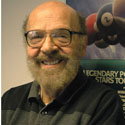 Tips & shafts By George Fels Consulting Editor George Fels has been writing for Billiards Digest since 1980, and his "Tips & Shafts" column is usually our readers' first stop when they crack open the magazine. For better or worse, pool has been his only mistress for 40-plus years.
Archives
Best of Fels
|
|
August: The Polish Prince August 2012 OK, CUE-GAMES trivia experts: can you name a competitor who made his tournament debut at the sprightly age of 67? It's only been done once that I know of, and you'd have to be pretty current to come up with that occasion, as it took place just last May. The player making his 3-cushion billiards bow was the pride of Racine, Wis., George Pawelski, aka The Polish Prince for most of his pool career. And pool, especially 14.1, is basically what he's known for.
Back in the late '60s and into the early '70s, when straight pool was still the tournament king, George Pawelski was at least a top-20 player and quite possibly higher. His long run exceeded 300. No less than perennial champion Luther "Wimpy" Lassiter declared that he had not seen a stroke like George's since the immortal Jimmy Moore. And it was Lassiter who furnished the competition from which Pawelski's moniker sprang, in a prestigious Detroit meet called the Motor City Open.
"We both had long runs in the sixties, and were playing a good, close match when the air-conditioning went out," George recalls, "and from then on, it was like playing on Velcro. With a lot of misses and back-scratches, we both managed to get within a rack of game. I had him on two scratches, and pinned to a back rail. I did leave him the edge of a 9 ball - of all balls - and he had to back-cut it, with the balls sticking together like baked beans. But he didn't want to re-break the balls with me needing just 11 or 12, so he took a chance on that 9, sliced it in, broke the cluster and ran out."
Following the heartbreaking loss, George was taken to dinner by another future Hall of Fame inductee, the late Harold Worst, who was far less idolatrous of Lassiter than most. "I really like the way you play," Worst told Pawelski, "and from this day forward, you are officially 'The Polish Prince'." Seldom if ever has a pool player worn a nickname with more enduring pride than Pawelski, who has even had the moniker decaled on his car.
Then he entered into one of those "You can have me or you can have pool"-type marriages, and was gone from the game for over a generation. Exactly how and why his wife began to mellow on the subject is not known, and sundry health problems have held back his return to actual competitive play. But for the past 19 years George has been the teaching pro at the great Milwaukee room Romine's. The latter is one of those relatively rare sports bars that honors pool (and billiards) rather than merely including it; it probably doesn't hurt that owner Terry Romine is a crackerjack player at both games himself, and George Pawelski, with his relatively low-cost lessons, has flourished there.
It's unlikely, however, that he's ever going to teach anyone how to hit the ball precisely as he does. The only pool pro active today whose stroke compares to George Pawelski's is another Wisconsin product, Larry Nevel. It's still a thing of beauty today, although perhaps not as ostentatious a delivery as Nevel's. Pawelski's stance is close to half-sideways, recalling Greenleaf, with a sweeping backswing; throw in his center-part haircut and he appears to have arrived for competition through time-travel. (He can still execute most of Worst's spectcular exhibition draw-shots today.)
Wisconsin has never exactly been a hotbed of pool. Nevel and fellow pro Jeff Carter were both born in Beloit but headquarter elsewhere today; in earlier eras, Milwaukee's Verne Petersen and the Covington brothers, Willis and Todd, were considered national-class straight-pool players. Famed pool teacher Jerry Briesath was, too, as a younger man. And an oddity in George Pawelski's background is his never having been mentored by that state's other famous teacher, Frank "Sailor" Stellman, despite their geographical proximity (Stellman's hometown, Kenosha, borders with Pawelski's). "Sailor spent about ten minutes with me once," he recalls wryly today. The two men have not spoken in over three decades, even though George used to represent Sailor's well-known line of cues. George is, however, quick to admit that, strictly as a player, he had deep respect for, and learned a great deal from, watching the man.
George's tournament-caroms bow took place at Chris's Billiards in Chicago, against an 18-player field that could reasonably be described as regional-calibre. That majestic stroke does indeed seem better suited to billiards than pool, where it suggests using a howitzer to swat flies. And all he could do with it was march undefeated through his round-robin bracket, eventually finishing third, playing at a level close to .7 throughout. In the few matches he did lose, he lauded his opponent's play with real applause, not finger-snaps, and seemed radiantly happy to be where he was, win or lose. That monster stroke notwithstanding, rarely did he force the cue ball anyplace, scoring the vast majority of his points off shots involving the minimum three rails. When he had to cut the first object ball thin, it was as though he had never been away from pool, let alone billiards. He doesn't get to practice billiards much, and had never played on Chris's heated Verhooven tables; new cloth, with its usual one-diamond-longer mysteries, added to the challenge. Yet he looked as though he had never played anywhere else.
"Do you play billiards at all?" he asked me later.
"Probably my best game, George. I'd be competitive with roughly the bottom half of this field. But nothing like you."
"Not bad for 67 years old, huh?" he crowed. "Never played in a billiards tournament in my life. What about you? How old are you now?"
I confided, in something less than enthusiasm, that I was nearly seven years his senior. "Too late for an old coot such as I," I added. "But you, George, now you've got a real future in this game."
|





